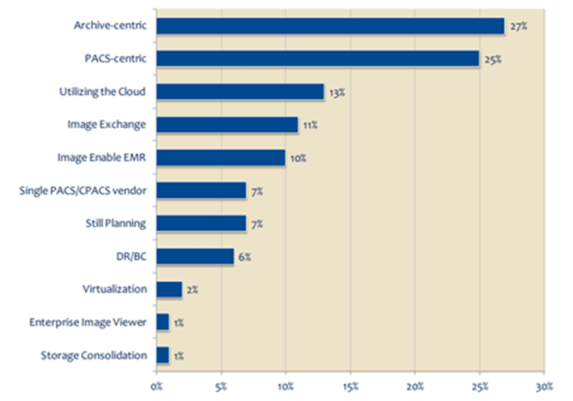VNA or PACS-centric Models Lead Enterprise Imaging Plans
Most healthcare providers developing an enterprise imaging strategy are considering a vendor-neutral archive or a PACS enterprise archive solution, KLAS found.
Most healthcare providers developing an enterprise imaging strategy are considering a vendor-neutral archive or a PACS enterprise archive solution, according to a new KLAS report.
The report, Enterprise Imaging 2012: Provider’s Strategies and Insights, found that most providers are in the early stages of forming the strategy that would allow access to images at the right time and place, according to market research firm KLAS.
"Image storage is a necessity, no matter what option is chosen," said Ben Brown, imaging research director and author of the report. "As providers start to bring in more studies and the studies themselves increase in size, the need for storage will increase. In addition, as a provider explained, images will need to be managed as well as stored."
Of the providers interviewed, 27 percent said that a vendor-neutral archive (VNA) would be central to their strategy. This option was selected most often by hospitals with more than 500 beds. A PACS-centric archive solution was selected by 25 percent of providers, most of them facilities with fewer than 500 beds.
GE and Philips were mentioned most often by those interviewed, and customers said they considered their vendor to be part of the imaging strategy moving forward, particularly for a PACS-centric approach. Fuji also has a strong PACS enterprise archive offering, according to KLAS. Agfa and Merge were most often cited for VNA approaches.
Provider Reported Enterprise Imaging Strategy:

chart credit: KLAS
The Reading Room Podcast: Current Perspectives on the Updated Appropriate Use Criteria for Brain PET
March 18th 2025In a new podcast, Satoshi Minoshima, M.D., Ph.D., and James Williams, Ph.D., share their insights on the recently updated appropriate use criteria for amyloid PET and tau PET in patients with mild cognitive impairment.
Expanded FDA Approval Allows Use of Pluvicto Prior to Chemotherapy in Patients with mCRPC
March 28th 2025Recent research demonstrated a 59 percent reduced risk of progression or death with the radioligand therapy Pluvicto in comparison to a change of androgen receptor pathway inhibitor (ARPI) for patients with metastatic castration-resistant prostate cancer (mCRPC).
New AI-Enabled Portable Ultrasound May Facilitate 50 Percent Reduction in Cardiac Imaging Scan Time
March 28th 2025Artificial intelligence (AI)-powered measurement capabilities provide key features with the Compact Ultrasound 5500CV device, which will be unveiled at the American College of Cardiology (ACC) conference.